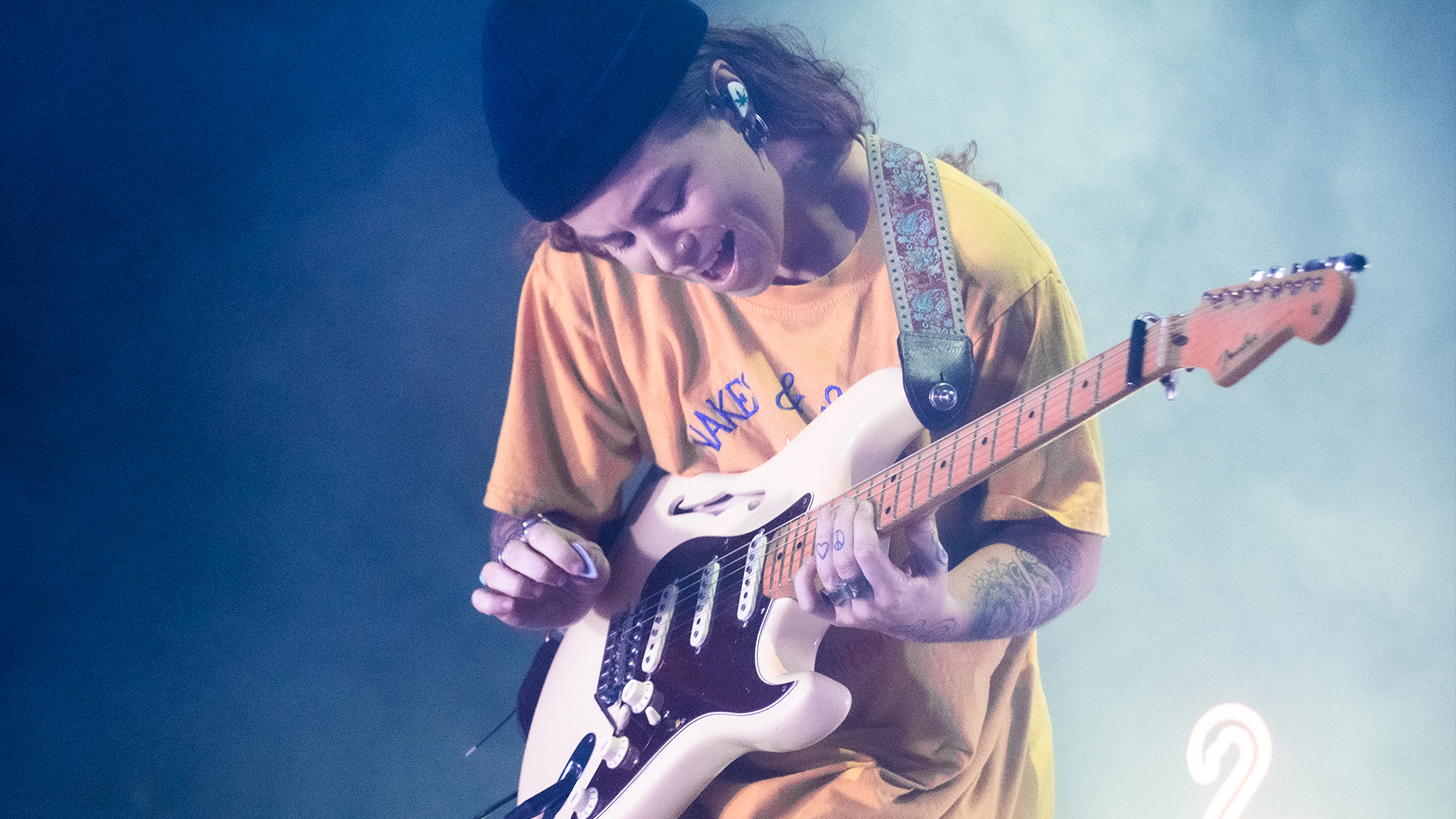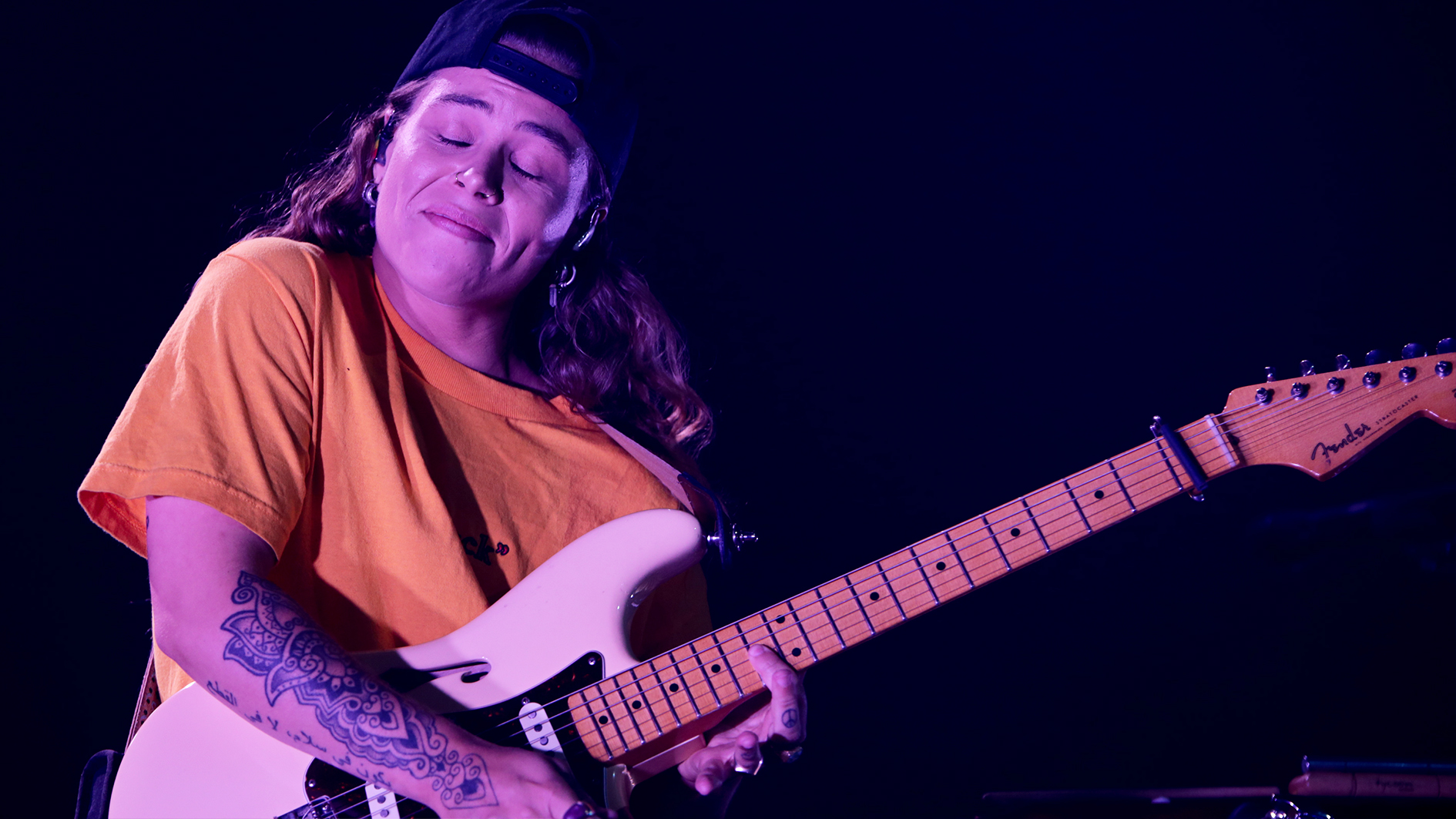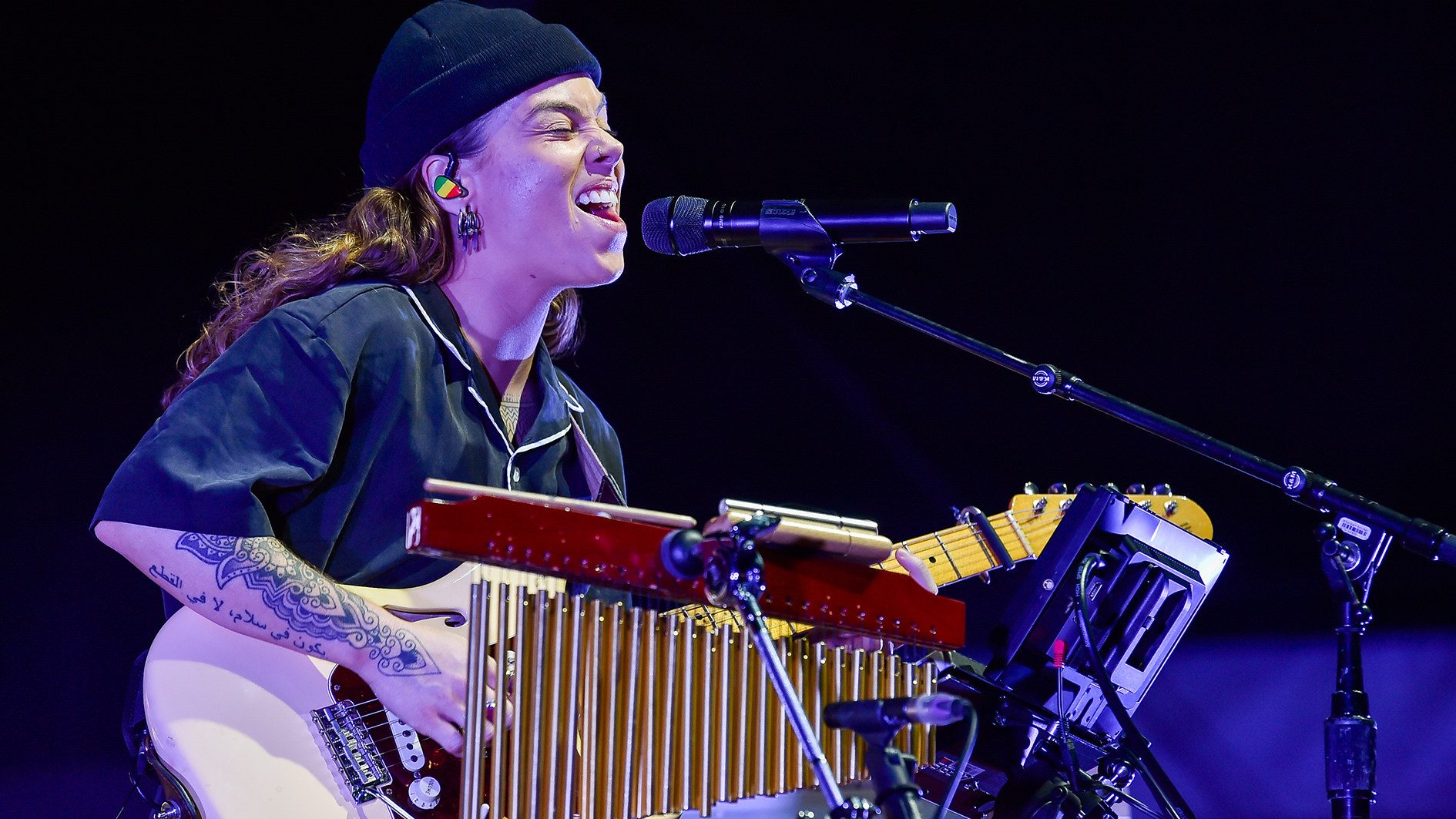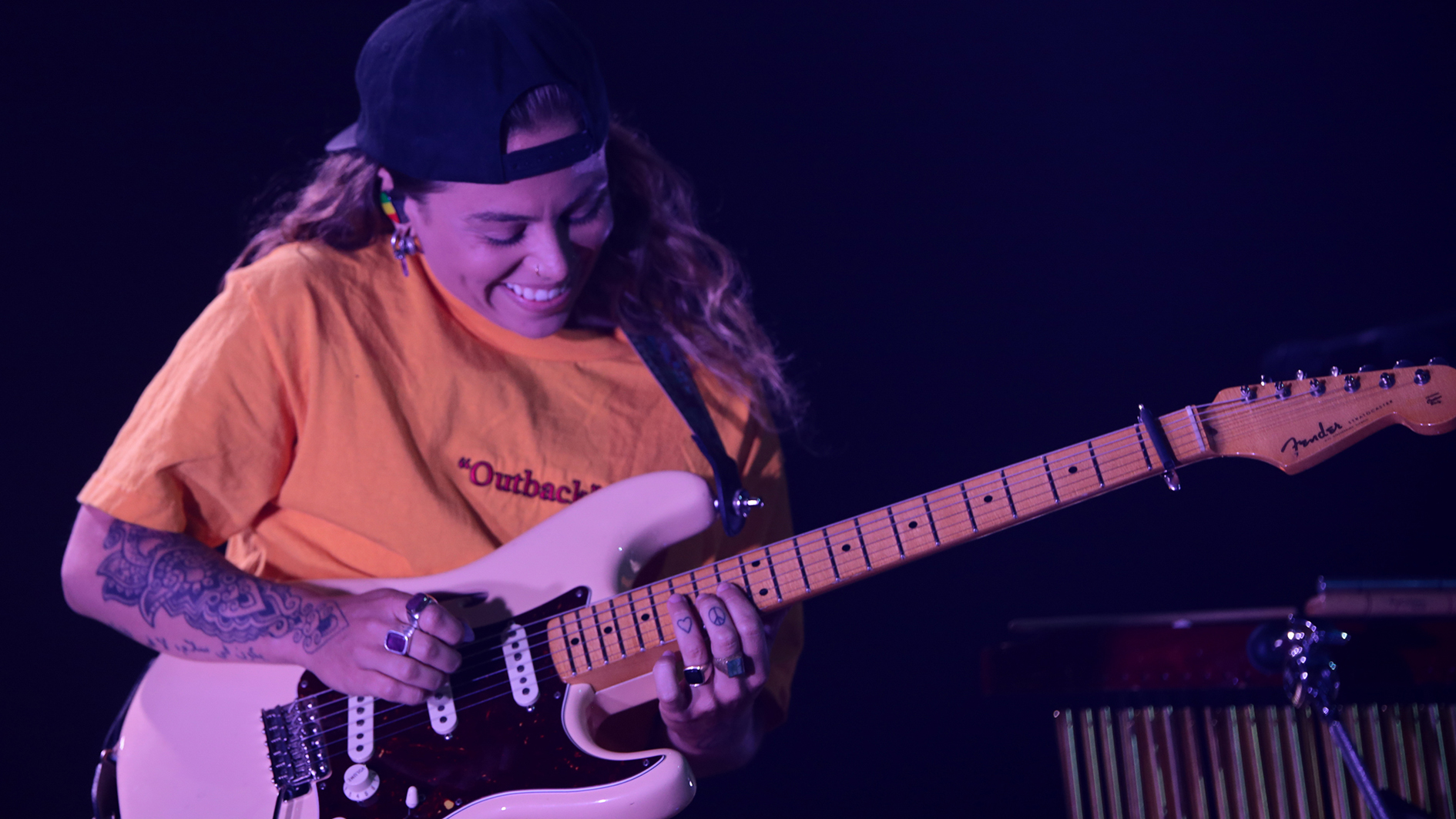Tash Sultana: "I can play different instruments, but my home is the guitar"
The Aussie multi-instrumentalist talks us through their extensive live setup, love of Fender's Richie Kotzen Teles, and the $20 pedal that will never leave their pedalboard

“Who the fuck would’ve thought everyone’s gigs would get cancelled?!” ponders Tash Sultana. Like many musicians, the Australian singer-songwriter and multi-instrumentalist had big plans and the best of intentions for 2020 - most of which have now evaporated into uncertainty. “And it’s happening all over, not even just five continents but worldwide.”
There are, however, silver linings behind the clouds. For Tash’s latest single, Pretty Lady, fans and friends self-isolating around the world were recruited to send in their clips for the video, its original concept having been thwarted by this year’s unexpected turn.
“We had a different idea originally,” explains Tash, when told that - despite the odds - the footage depicts humanity in a state of unity and resilience, in spirit the very antithesis of isolation. “All of a sudden, as we were trying to get everything together all these bans came in and there were no flights to get anywhere.
"We couldn’t do what we wanted to do because everything was very strict. But it turned out cool, we ran a little competition for everyone sending in clips - The Pretty Lady Challenge. I did a painting... and I don’t paint. Actually, I’m a fucking shit painter… but a little girl won it and was really stoked. So at least some good came out of it!”
Here the Australian singer-songwriter talks us through the secrets to looping live on stage, why a blend of digital and analog gear works best and that one pedal that will never lose its spot on the 'board...
You’ve used Jazzmasters, Strats and Teles in the past. What are we hearing on the new single?
I have so many amps... but Kemper and Axe-Fx have been way better for me
“I haven’t actually played a Telecaster in a long time. I used a 12-string Fender Stratocaster, this limited edition remake of a '60s electric 12-string. They only made 10 and I got the last one. That was combined with my 1960 relic Strat, which I’ve changed the pickups in - it has DiMarzio noiseless single-coils fitted now. I don’t use an amp or anything like that - everything is digital.
Get The Pick Newsletter
All the latest guitar news, interviews, lessons, reviews, deals and more, direct to your inbox!
“I have so many amps... but Kemper and Axe-Fx have been way better for me. We were using Kemper initially, programming it on a hybrid MIDI system with a couple of analog pedals, and pages and banks of tones. But you could only bank five different tones at once.
"The Axe-Fx is more effects-driven, so I use all my tones and amp simulations from that. Everything is set so it sounds just like how I do on the album. Then I run my solo sounds as two separate stereo sends to two different Kempers, before blending it all together!”
Are there any other guitars in the collection you don’t use as much?
“I wouldn’t really say I have any strange guitars - they’re all quite common but set up really nicely for how I like to play. There are also certain things we’ve done with the internals that I will never give away, ways to make my sound thinner, fatter or buzz less.

"Using noiseless pickups helps - it’s something my tech suggested. The DiMarzios have that really whole, full tone. I know a lot more about digital things and software than I do about pickups and wood, to be honest!
“This is where my tech comes in handy, he’s had all this experience and it helps me find out new things to try. There’s a Richie Kotzen Telecaster that I really loved the full sound of, and that guitar has single-coil DiMarzios – which they make for Stratocasters as well, so I’ve been using those to fatten up my tone.
"Those Richie Kotzen models sounds bigger than all the other Teles. I’ve never found a better-sounding Telecaster: it’s not thin or twangy, it’s really rounded and smooth as fuck. So I nicked that kind of sound for my Strats.”
Tell us more about the analog pedals you ended up keeping...
I use the Mini Cry Baby because I have really f**kin’ small feet!
“I still love using a Mini Cry Baby wah. I’ve tried using MIDI simulation to do that as well, but it doesn’t have the same cut and pass feel on it. Those things feel very different to an analog wah and I was just not into it. So I use the Mini Cry Baby because I have really fuckin’ small feet.
"There’s also a Boss Digital Delay, that classic blue and white one that everyone has got [most likely a DD-3]. I tried to get rid of it but I just loved the functionality of it and the way you can turn knobs to create new sounds. You can fuck with your decay, speed, repeats and levels. I also use an [Electro-Harmonix] Canyon pedal to do tape delay harmonics.
“I have this really shitty $20 pedal that I got when I was 13 - it’s still on my 'board today. It’s this Legacy distortion pedal that got discontinued years ago, that’s generally what I use for my screeching guitar solos. I’ve never found a tone I like more than that, not on an Axe-Fx or Kemper or anything! It’s that one fuckin’ pedal I’ll never get rid of.”
So for pitch-shifting, are you mainly using the Axe-Fx?
“Yep - now it’s different because it’s done through that, but before I actually used this bass octave shifter [Beta Aivin OC-100 Super Octave]. As you’d expect, it gave me a really good-sounding bass tone out of an analog pedal using my guitar, which had a split mix of heavier gauge strings on the brass ones and lighter ones for steel.
“I like harmonizing with myself, too, without any effect. I especially like using octaves, thirds and fifths. Depending on the scale of the key, I might use the second or fourth. Some really work and some sound really fucked, so you learn not to do them.
"I pick in a hybrid style, so with the pick as well as my middle finger, ring finger and pinky at the same time. I don’t like playing without a pick, but I don’t like not using my fingers, either!"
Though it’s not strictly blues, there are a lot of pentatonic lines in your songs...
I don’t really have any particular guitar players I idolize - I’m more into the sounds than the player
“We all came from a blues scale in the beginning. Whether you call it Mixolydian or pentatonics or whatever term applies to the genre… it’s still born from the blues. When you first start learning guitar, the easiest parts to learn are blues solos.
"I don’t really have any particular guitar players I idolize - I’m more into the sounds than the player. But if I had to pick someone, I really love John Mayer’s approach to soloing. I love the fuck out of Jimi Hendrix, too.”
How about the jazz side of it - are you much of a theory buff?
“I’ve studied shit-all, bro! I’ll probably start doing more now but I haven’t done much of it in the past. It’s more about feel, sound and approach. What I love most about jazz is that super-clean and warm tone. I didn’t know what key or scale I was playing in for a long time.
"It’s different now from my experiences in the studio, when I’m trying to transcribe things across different instruments - it’s quite difficult if you don’t know what key you’re in. Thankfully, that’s changed a bit...”

How easily does the theoretical knowledge transfer from instrument to instrument?
“Knowing what key you are in and what scales you can apply is really important. Once you’ve learned it, it’s quite easy to transfer the information from guitar to keys.
"Say you play in C Major on guitar, which is quite easy, it’s also very easy on keys. There are apps now that can help you find these things out if you don’t know them – you can literally Google the fretboard or piano notes and figure it all out. You can even look at all the chord shapes and see how they change from sevenths to ninths or whatever. We live in such a virtual world, it’s easy to get those answers really quickly.”
You recently switched to a band setup for your live shows. Considering how well you were doing as a solo musician, what made you want to change?
I wanted to hear how much these musicians loved playing. You can really hear the passion when they do
“It doesn’t take away from what I do on my own; it’s adding to it in a sense. I’m not throwing away what I’ve achieved on my own - I’m still going to do that. I just wanted a section of the set where I was accompanied by other people. I also really wanted to crowd-surf and was trying to figure out the best way to do that… which is with a band!
“They’re all lovely, everyone can play their instruments really well and play my songs really well. You’d hope that the drum parts I’ve put down being played by an actual experienced drummer would sound better, and they do.
"I can play different instruments, but my home is the guitar and that’s how the other players are with the keys or drums. That’s the approach I was looking for… I wanted to hear how much these musicians loved playing. You can really hear the passion when they do.”
What did you learn from performing all those years out there by yourself?
“I think you need one clean power source. You don’t want to be dealing with daisy chains and all these nine-volts going into a wall. Put all your pedals onto the 'board and use high quality cables - they really do affect your signal path.
"If you get one of those big power supplies with 9, 12 or 18-volt ports on them, you can then send the right amount of power to each pedal, which will make your tone cleaner. That said, having less pedals will give you a cleaner tone, which is why I moved to digital. I didn’t want heaps and heaps of effects anywhere…”
Looking back now, how bad did it get?
We had a lot of problems at venues, especially in America, losing valuable time trying to isolate noises coming through somewhere in the chain
“I had two for the Korg [synth], two for the Nord [synth], six underneath me, another 20 on a different 'board (laughs)! I’d say about 25 to 30. It was pretty crazy and not the best way to run things - there was so much signal flow in different directions.
"We had a lot of problems at venues, especially in America, losing valuable time trying to isolate noises coming through somewhere in the chain. That was a big reason to go digital, and to be honest it’s more of a hybrid because I still have a few pedals.”
What’s the secret to keeping all your loops in time when you’re up there alone?
“We built our own loop system because I didn’t like any of the generic ones on the market. For what I was trying to achieve, the kind of thing I was after was not really able to be purchased. So we built our own custom one.
"I hate being tied to one stereo in and stereo out. You can only achieve so much with that, especially when it comes to tones and running multiple things like synthesizers into keyboards and pads.

“Earlier on it was just double mono and grouping them guitars left and keys right. It was a two-channel mix at best with snapshots of each song to help mix it better… that was just not a reliable way. We searched high and low.
"We even tried to jailbreak the Roland 505 software to quantize two loop stations, both running on their own internal clock without latency… but that didn’t work. We had to build our own. It took two years! I wanted stereo everything… and it wasn’t possible, even with MIDI. Now I have it.”
Amit has been writing for titles like Total Guitar, MusicRadar and Guitar World for over a decade and counts Richie Kotzen, Guthrie Govan and Jeff Beck among his primary influences as a guitar player. He's worked for magazines like Kerrang!, Metal Hammer, Classic Rock, Prog, Record Collector, Planet Rock, Rhythm and Bass Player, as well as newspapers like Metro and The Independent, interviewing everyone from Ozzy Osbourne and Lemmy to Slash and Jimmy Page, and once even traded solos with a member of Slayer on a track released internationally. As a session guitarist, he's played alongside members of Judas Priest and Uriah Heep in London ensemble Metalworks, as well as handled lead guitars for legends like Glen Matlock (Sex Pistols, The Faces) and Stu Hamm (Steve Vai, Joe Satriani, G3).
Ozzy Osbourne’s solo band has long been a proving ground for metal’s most outstanding players. From Randy Rhoads to Zakk Wylde, via Brad Gillis and Gus G, here are all the players – and nearly players – in the Osbourne saga
“I could be blazing on Instagram, and there'll still be comments like, ‘You'll never be Richie’”: The recent Bon Jovi documentary helped guitarist Phil X win over even more of the band's fans – but he still deals with some naysayers











